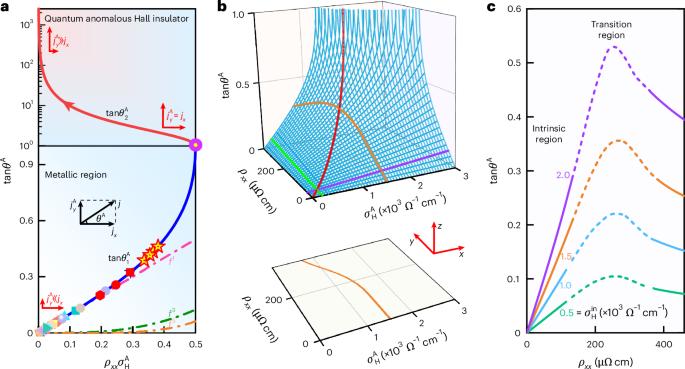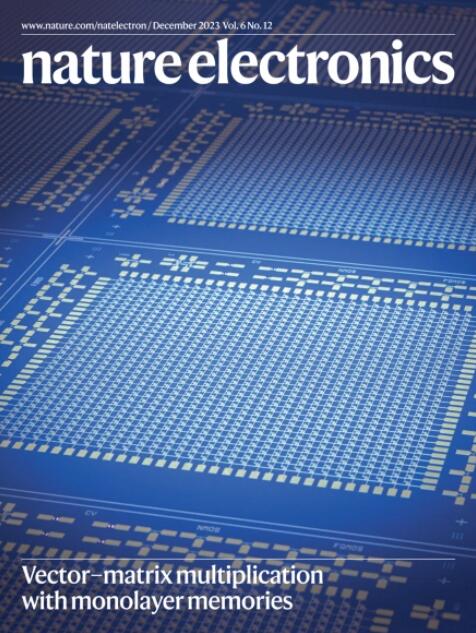磁性拓扑半金属中的反常霍尔角调制
IF 40.9
1区 工程技术
Q1 ENGINEERING, ELECTRICAL & ELECTRONIC
引用次数: 0
摘要
反常霍尔角(θA)是衡量将纵向驱动电流转换为横向自旋极化霍尔电流的效率。在基于反常霍尔效应的传感器中,较大的反常霍尔角可以提高磁场检测的灵敏度。然而,这个角度的调制是具有挑战性的,磁性材料通常具有0.1°-3°的低角度。本文报道了磁Weyl半金属Co3Sn2S2中θA的调制。我们证明了异常霍尔角参数tanθA可以表示为电阻率与异常霍尔电导率乘积的函数。我们使用该方案来演示tanθA调制到0.46的幅度,对应于约25°的角度。我们进一步使用掺铁的Co3Sn2S2单晶纳米片制备了异常霍尔器件,并证明了霍尔灵敏度为7,028±341 μΩ cm T-1,磁场检测率为23.5±1.7 nT Hz - 0.5。本文章由计算机程序翻译,如有差异,请以英文原文为准。


Modulation of the anomalous Hall angle in a magnetic topological semimetal
The anomalous Hall angle (θA) is a measure of the efficiency of converting a longitudinal driving current into a transverse spin-polarized Hall current. In sensors based on the anomalous Hall effect, a large anomalous Hall angle can improve the sensitivity of magnetic field detection. However, the modulation of this angle is challenging, and magnetic materials typically have low angles of 0.1°–3°. Here we report the modulation of θA in the magnetic Weyl semimetal Co3Sn2S2. We show that the anomalous Hall angle parameter tanθA can be formulated as a function of the product of electrical resistivity and anomalous Hall conductivity. We use this scheme to demonstrate the modulation of tanθA up to a magnitude of 0.46, corresponding to an angle of around 25°. We further fabricate anomalous Hall devices using Fe-doped Co3Sn2S2 single-crystalline nanoflakes and demonstrate a Hall sensitivity of 7,028 ± 341 μΩ cm T–1 and a magnetic field detectability of 23.5 ± 1.7 nT Hz–0.5 at 1 Hz. The anomalous Hall angle parameter tanθA can be formulated as a function of the product of electrical resistivity and anomalous Hall conductivity, a scheme that allows the anomalous Hall angle in the magnetic Weyl semimetal Co3Sn2S2 to be increased to 25°.
求助全文
通过发布文献求助,成功后即可免费获取论文全文。
去求助
来源期刊

Nature Electronics
Engineering-Electrical and Electronic Engineering
CiteScore
47.50
自引率
2.30%
发文量
159
期刊介绍:
Nature Electronics is a comprehensive journal that publishes both fundamental and applied research in the field of electronics. It encompasses a wide range of topics, including the study of new phenomena and devices, the design and construction of electronic circuits, and the practical applications of electronics. In addition, the journal explores the commercial and industrial aspects of electronics research.
The primary focus of Nature Electronics is on the development of technology and its potential impact on society. The journal incorporates the contributions of scientists, engineers, and industry professionals, offering a platform for their research findings. Moreover, Nature Electronics provides insightful commentary, thorough reviews, and analysis of the key issues that shape the field, as well as the technologies that are reshaping society.
Like all journals within the prestigious Nature brand, Nature Electronics upholds the highest standards of quality. It maintains a dedicated team of professional editors and follows a fair and rigorous peer-review process. The journal also ensures impeccable copy-editing and production, enabling swift publication. Additionally, Nature Electronics prides itself on its editorial independence, ensuring unbiased and impartial reporting.
In summary, Nature Electronics is a leading journal that publishes cutting-edge research in electronics. With its multidisciplinary approach and commitment to excellence, the journal serves as a valuable resource for scientists, engineers, and industry professionals seeking to stay at the forefront of advancements in the field.
 求助内容:
求助内容: 应助结果提醒方式:
应助结果提醒方式:


